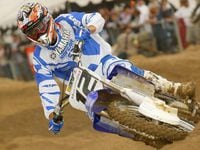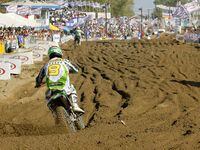"The boring races are good for someone," said Carmichael with two rounds left to go in another undefeated season, "and I'm going to take them as long as I can." Boring? Well, maybe "predictable" would be a more accurate depiction of the '05 250 class (newly renamed Motocross class) Motocross season.Many people were forecasting—or perhaps just hoping for—a very competitive 250 class in this year's AMA Motocross Series. Bubba was moving up and Reed had reportedly upped his game. But in case anyone had forgotten how untouchable RC is in the outdoors, he quickly reminded everyone. At the beginning of the series, fans thought, "Stewart might have a shot at the Championship!" As the season got underway, that thinking shifted to: "Well, maybe he'll win a few motos..." and finally, "If you bet against RC, you're just plain stupid!"And the predictability in the Motocross class goes beyond just RC. Aside from Stewart's turbulent results and Reed's incomplete season, lets face it, there are airline schedules less consistent than the front pack of the 250 class. In fact, in the second half of the series, overall results from the top five riders rarely varied by more than one position. Even the time intervals between riders began to show regular trends.It all goes to show how vital consistency is for survival in the premier class of the AMA Motocross Series (just ask Stewart about that). But if you were still longing to see unpredictable, bar banging, close racing, the 125 class (newly named Motocross Lites) was the series to watch this summer.
On the polar opposite end of the solid 250 class was the 125 class. In our preseason predictions, many people commented on the large talent pool. "There's not just one good guy ; there's 10!" commented Mike Alessi at the Glen Helen prequel. His predictions could not have been more accurate as there were no less than ten different moto winners throughout the season. There were six different overall winners, three different riders held the series points lead at one time, and perhaps the most shocking statistic is that nearly every round winner also scored a DNF at some point (the only one who didn't ultimately walked away with the title).However, if you want to get technical, you could point out that Tedesco had one zero-point moto. During the first moto at Glen Helen, Tedesco crashed and barely made it to the finish in 22nd place, outside of a point-scoring position. Statistically, that could be equivocated with a DNF.The contrasting statistics of these two classes definitely reveals a different style between them. But what is the reason behind it? Why are the 250 class results so solid while the 125s are all over the board? To find the answer, we went straight to the source. Team managers, seasoned veterans, rookies and those with experience in both classes gave us their take on the contrasting characteristics of the two classes.Pro Circuit's Mitch Payton, an icon of the sport in his own right, states, "The difference in the results in the 250 class is because those are all ex 125 guys probably past champions, so they're more consistent and more mature—the cream rises to the top. The fastest guy is the fastest guy in both motos and the second fastest is the second fastest... and so on. Whereas in our class , you see a lot more guys with like a 6-1 or a 3-8."Payton also went on to point out the importance of a good start. Of course, this is vital in any race, but even more so in this case. "The 125 class is driven a lot from starts. You have to start up front because there's not five fast guys; there's ten guys that can all run the same pace—at least for a while. If you get the start, it gets you far enough away from battling with a bunch of guys and getting stuck in the pack. Whereas in the 250 class, even if you started in the back of the pack, a guy will come all the way to third no matter what."Kevin Windham backed up that claim at Steel City when a crash off the start left him in 20th place. He pushed hard and steady to bring it all the way back to his usual second place by the moto's end.Jeff Alessi, one of the youngest riders on the circuit, began his season aboard a 450, but a few weeks ago he received a call from his older brother's team inviting him to enjoy the KTM factory life aboard a 250F for the remaining rounds of the series. Having experienced racing in both classes during his rookie season, Jeff had some insight on the subject, and also seconded Mitch Payton's hypothesis."The 125 class definitely has a lot more talent there," Jeff explained. On the surface, that's a bold statement, but he makes a sound point—referring to the number of competitive riders in the class, not the amount of talent any single rider has. "The guys are just coming out of the amateur ranks and then there's guys that have been there for five or ten years. It's a really tough class to do good in. It's more about your start. If you don't get a good start, you're not going to do well. They're going full-speed from lap one to the last lap. Whereas in the 250 class, those guys are a little more mature and a little older and there's not so much talent in that class. It's like the first eight guys are really, really fast, and then from eighth on, they're more of good local pro riders."The decisive emphasis put on the start of a 125 moto could also explain why we've seen so many first-turn crashes. Team Suzuki's Rick Johnson, a former Motocross Champion and all-around legend, agrees. "Unless you're Mike Alessi and get a lot of holeshots, you've got a lot of guys fighting for a position, and they all feel that they can win. You have a bunch of alpha males fighting for one spot. Something's gotta give."Johnson went on to point out that the close racing is also due to riding style, "The 250Fs, guys can ride them closer to the edge than the 450s. The 450 more finesse, and you have to be really strong—like Carmichael—to really bully the thing around. But on the 250F, you pin it. And a lot of the guys are pinning it. So it makes it almost like restrictor plate racing in NASCAR where you get a bunch of guys occupying the same space."Everyone on the circuit generally accepts the fact that 450s require patience and finesse, while 250Fs require being pushed to the edge. With that in mind, it brings about another difference between the two classes: Machinery. Pro Circuit's Mitch Payton commented on the importance of a fast bike. "All the are fast enough . It's more just stacked on the rider's ability and being in shape. A good 450 can run whether it's production or a works bike. It doesn't really seem to matter."You can read from that the fact that it does matter in the 125 class. Ryan Hughes made a mid-season switch from a CRF250R to an RM-Z450 for just that reason. "On the 250F racing against the factories and Pro Circuit where they have the unlimited budget. They can test and further their bikes and we didn't have the ability to do that (as a privateer). So I decided to switch to the 450 class and switch to Suzuki because I'm going to be riding in the WORCS Series for the next two years for Suzuki." (I know, whole other story right there.)Ryno, a former champion with experience in both classes, had insight on the class difference similar to Jeff Alessi's. "In the 125 class, the depth is a little bit more. The riders are young, so they—like we all did when we were young—all did some bonehead moves. There are so many young and hungry kids coming up that it makes it that much more up and down. The 250 class doesn't have as much depth; the riders are a bit more seasoned and don't make as many mistakes. When you got Carmichael and the big three, four guys, who's going to beat those guys? Nobody. In the 125 class, a privateer can with one good race, just not consistently."While Hughes moved from the 125 to the 250 class, Jeff Alessi made the opposite move (from the 250 to the 125 class). But after their transitions, they both seemed to bring in better results, which shows how the 125 class reinforces fast, aggressive riders while strong, mature, experienced riders are rewarded in the 250 class."A lot of the guys in the 250 class are older, more mature and most of them have won championships; they know what they're up against," Rick Johnson sums up, "They have a game plan. In the 125, it's a lot of younger guys looking for their first championship. I would say that the competition is closer. It's not better—obviously the best riders are in the 250 class—but in the 125 class, I think the difference between first and tenth is maybe a second or two (when they all run their best laps). In the 250 class, in some cases, Ricky Carmichael has four seconds on second place, so there's some bigger gaps. But in the 125 class, everyone is really close, everyone's trying hard and everybody's still learning. So it's just maturity."
So whatever you want to call them250s and 125s, Motocross and Motocross Lites, MX1 and MX2, Majors and Minors, Diesel and Premium, Creamy and Extra Chunkythe two-classes have their obvious defining characteristics. And best of all, each gives fans what we can't seem to get enough of: Standing in awe of the unbelievable speed, power and precision of the 450s, and the bar-banging, unyielding competition of the 250Fs.



/cloudfront-us-east-1.images.arcpublishing.com/octane/XQORS527YFFT3MVI326EOEYJUI.jpg)
/cloudfront-us-east-1.images.arcpublishing.com/octane/TVDPP3TGMZHODFXASIFUM2KD34.jpg)
/cloudfront-us-east-1.images.arcpublishing.com/octane/EWDMR3DDTBBQPI7DQVZCLMRFAE.jpg)
/cloudfront-us-east-1.images.arcpublishing.com/octane/4XHHLVOUKFE3PDSWNSV4JJMGOE.jpg)
/cloudfront-us-east-1.images.arcpublishing.com/octane/5RLI3NQKQJA3LKKCQHRXQFTL6Q.jpg)
/cloudfront-us-east-1.images.arcpublishing.com/octane/3QCYJCI2RNBENIRWAKEOEKHFUM.jpg)
/cloudfront-us-east-1.images.arcpublishing.com/octane/UZHF7KAE7BFN7KU734ER7PPP3Q.jpg)
/cloudfront-us-east-1.images.arcpublishing.com/octane/XJFFFMRN6VEZ7CDNAGKWVPC3H4.jpg)
/cloudfront-us-east-1.images.arcpublishing.com/octane/RMC3CHWSHFAUJA2WJ2FVG4NBOA.jpg)
/cloudfront-us-east-1.images.arcpublishing.com/octane/WXEZV4WAYBERFKSRE5M7GQBW7A.jpg)
/cloudfront-us-east-1.images.arcpublishing.com/octane/LO3PZVGICFGJZBNUA2ORUSAUSE.jpg)
/cloudfront-us-east-1.images.arcpublishing.com/octane/UFHLTNOXLVARVLZV32M6ZJZV4Y.jpg)
/cloudfront-us-east-1.images.arcpublishing.com/octane/CTSWNU7SNNCC3LWB2KATYZ5AXY.jpg)
/cloudfront-us-east-1.images.arcpublishing.com/octane/IBNGAQWHJJF4TKSIQT54MTWRYQ.jpg)
/cloudfront-us-east-1.images.arcpublishing.com/octane/EAEWHFARGVGHFH4N4BDOSNBJSU.jpg)
/cloudfront-us-east-1.images.arcpublishing.com/octane/AZ7H35TQSZDKZCVM4S6CHERQEU.jpg)
/cloudfront-us-east-1.images.arcpublishing.com/octane/GYMIU7SMN5CWHP6QLFR6MVKEBU.jpg)
/cloudfront-us-east-1.images.arcpublishing.com/octane/B3CX7C4BFFCKBLDWHPQFACBH2E.jpg)
/cloudfront-us-east-1.images.arcpublishing.com/octane/6EIBG7NN4BH4FKDBCPCTLQL6FU.jpg)
/cloudfront-us-east-1.images.arcpublishing.com/octane/3RBI4ZG5NNBCTEUK7MWMKVZ5BE.jpg)
/cloudfront-us-east-1.images.arcpublishing.com/octane/3QKLYI2BWVAMRNNFC5KCGUYRAU.jpg)
/cloudfront-us-east-1.images.arcpublishing.com/octane/B7ITEVP2MRGLXM37KQURRKCG3E.jpg)
/cloudfront-us-east-1.images.arcpublishing.com/octane/BMDGOMSLGFF7XDLBL5DVCTON6Y.jpg)
/cloudfront-us-east-1.images.arcpublishing.com/octane/AEPPASNAAJGXVLAXAH5RF3BDNY.jpg)